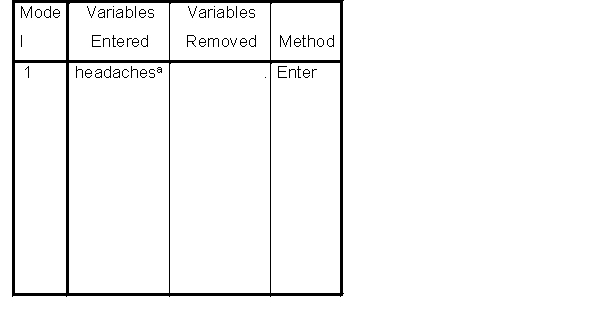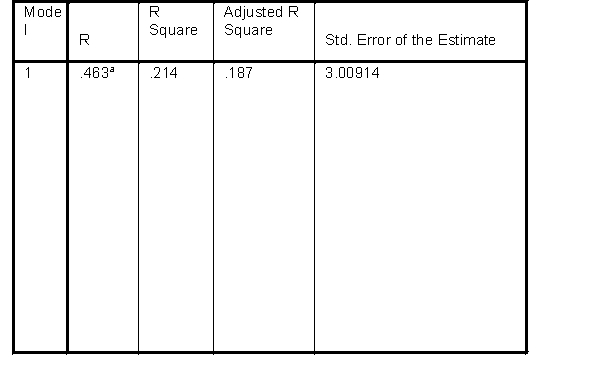Deck 10: Linear Regression
Question
Question
Question
Question
Question
Question
Question
Question
Question
Question

Unlock Deck
Sign up to unlock the cards in this deck!
Unlock Deck
Unlock Deck
1/10
Play
Full screen (f)
Deck 10: Linear Regression
1
In a multiple regression analysis for every one-unit increase in x, y changes by a certain constant amount.This refers to:
A)delta
B)a
C)beta
D)b
A)delta
B)a
C)beta
D)b
b
2
For every one standard deviation increase in mean initial thinking time, fatigue:
A)increased by .46 of a standard deviation
B)increased by .57 of a standard deviation
C)decreased by .57 of a standard deviation
D)stayed the same
A)increased by .46 of a standard deviation
B)increased by .57 of a standard deviation
C)decreased by .57 of a standard deviation
D)stayed the same
increased by .46 of a standard deviation
3
Questions relate to the following linear regression.
Variables Entered/Removedb
 a.All requested variables entered.
a.All requested variables entered.
b.Dependent Variable: memory/concentration
Model Summary
 a.Predictors: Constant), headaches
a.Predictors: Constant), headaches
ANOVAb
 a.Predictors: Constant), headaches
a.Predictors: Constant), headaches
b.Dependent Variable: memory/concentration
Coefficientsa
 a.Dependent Variable: memory/concentration
a.Dependent Variable: memory/concentration
The total amount of variance on memory/concentration scores in the sample which can be explained by headaches is:
A)67.6%
B)45.7%
C)42.1%
D)11.39%
Variables Entered/Removedb
 a.All requested variables entered.
a.All requested variables entered.b.Dependent Variable: memory/concentration
Model Summary
 a.Predictors: Constant), headaches
a.Predictors: Constant), headachesANOVAb
 a.Predictors: Constant), headaches
a.Predictors: Constant), headachesb.Dependent Variable: memory/concentration
Coefficientsa
 a.Dependent Variable: memory/concentration
a.Dependent Variable: memory/concentrationThe total amount of variance on memory/concentration scores in the sample which can be explained by headaches is:
A)67.6%
B)45.7%
C)42.1%
D)11.39%
45.7%
4
The measure of mean initial thinking time:
A)significantly predicted fatigue, t=29.99, p<.001
B)significantly predicted fatigue, t=2.812, p=.009
C)did not significantly predicted fatigue, t=20.933, p=.000
D)did not significantly predict fatigue, t=2.812, p=.009
A)significantly predicted fatigue, t=29.99, p<.001
B)significantly predicted fatigue, t=2.812, p=.009
C)did not significantly predicted fatigue, t=20.933, p=.000
D)did not significantly predict fatigue, t=2.812, p=.009

Unlock Deck
Unlock for access to all 10 flashcards in this deck.
Unlock Deck
k this deck
5
Questions relate to the following linear regression.
Variables Entered/Removedb
 a.All requested variables entered.
a.All requested variables entered.
b.Dependent Variable: memory/concentration
Model Summary
 a.Predictors: Constant), headaches
a.Predictors: Constant), headaches
ANOVAb
 a.Predictors: Constant), headaches
a.Predictors: Constant), headaches
b.Dependent Variable: memory/concentration
Coefficientsa
 a.Dependent Variable: memory/concentration
a.Dependent Variable: memory/concentration
In the population we are 95% confident that the true regression line lays somewhere between
A)976 - 3.885
B).207 - .826
C).516 - .676
D)None of the above
Variables Entered/Removedb
 a.All requested variables entered.
a.All requested variables entered.b.Dependent Variable: memory/concentration
Model Summary
 a.Predictors: Constant), headaches
a.Predictors: Constant), headachesANOVAb
 a.Predictors: Constant), headaches
a.Predictors: Constant), headachesb.Dependent Variable: memory/concentration
Coefficientsa
 a.Dependent Variable: memory/concentration
a.Dependent Variable: memory/concentrationIn the population we are 95% confident that the true regression line lays somewhere between
A)976 - 3.885
B).207 - .826
C).516 - .676
D)None of the above

Unlock Deck
Unlock for access to all 10 flashcards in this deck.
Unlock Deck
k this deck
6
Questions relate to the following linear regression.
Variables Entered/Removedb
 a.All requested variables entered.
a.All requested variables entered.
b.Dependent Variable: memory/concentration
Model Summary
 a.Predictors: Constant), headaches
a.Predictors: Constant), headaches
ANOVAb
 a.Predictors: Constant), headaches
a.Predictors: Constant), headaches
b.Dependent Variable: memory/concentration
Coefficientsa
 a.Dependent Variable: memory/concentration
a.Dependent Variable: memory/concentration
How much variance on memory/concentration scores can we expect to be explained by headaches in the population? Which is the correct answer?
A)67.60%; the r2 is adjusted upwards
B)45.70%; the r2 is adjusted upwards
C)42.10%; the r2 is adjusted downwards
D)11.39%; the r2 is adjusted downwards
Variables Entered/Removedb
 a.All requested variables entered.
a.All requested variables entered.b.Dependent Variable: memory/concentration
Model Summary
 a.Predictors: Constant), headaches
a.Predictors: Constant), headachesANOVAb
 a.Predictors: Constant), headaches
a.Predictors: Constant), headachesb.Dependent Variable: memory/concentration
Coefficientsa
 a.Dependent Variable: memory/concentration
a.Dependent Variable: memory/concentrationHow much variance on memory/concentration scores can we expect to be explained by headaches in the population? Which is the correct answer?
A)67.60%; the r2 is adjusted upwards
B)45.70%; the r2 is adjusted upwards
C)42.10%; the r2 is adjusted downwards
D)11.39%; the r2 is adjusted downwards

Unlock Deck
Unlock for access to all 10 flashcards in this deck.
Unlock Deck
k this deck
7
Look at the following output, which is from a study which focused on people with ME.They were given a set of neuropsychological computerised tests, and after the testing session, they self-rated their general fatigue.The predictor variable was a measure of mean initial thinking time.
Model Summary
 a.Predictors: Mean initial thinking time
a.Predictors: Mean initial thinking time
ANOVAb
 a.Predictors: Constant), Mean initial thinking time
a.Predictors: Constant), Mean initial thinking time
b.Dependent Variable: fatigue
Coefficientsa
 Coefficientsa
Coefficientsa
 a.Dependent Variable: fatigue
a.Dependent Variable: fatigue
Which is correct? The regression equation is y=:
A)11.834x + 1.191
B)1.191x + 11.834
C)11.191x - 11.834
D)none of the above
Model Summary
 a.Predictors: Mean initial thinking time
a.Predictors: Mean initial thinking timeANOVAb
 a.Predictors: Constant), Mean initial thinking time
a.Predictors: Constant), Mean initial thinking timeb.Dependent Variable: fatigue
Coefficientsa
 Coefficientsa
Coefficientsa a.Dependent Variable: fatigue
a.Dependent Variable: fatigueWhich is correct? The regression equation is y=:
A)11.834x + 1.191
B)1.191x + 11.834
C)11.191x - 11.834
D)none of the above

Unlock Deck
Unlock for access to all 10 flashcards in this deck.
Unlock Deck
k this deck
8
Questions relate to the following linear regression.
Variables Entered/Removedb
 a.All requested variables entered.
a.All requested variables entered.
b.Dependent Variable: memory/concentration
Model Summary
 a.Predictors: Constant), headaches
a.Predictors: Constant), headaches
ANOVAb
 a.Predictors: Constant), headaches
a.Predictors: Constant), headaches
b.Dependent Variable: memory/concentration
Coefficientsa
 a.Dependent Variable: memory/concentration
a.Dependent Variable: memory/concentration
The regression equation for the above analysis is:
A)memory/concentration = .516memory/concentration) +2.430
B)headaches = .516 headaches) + 2.430
C)memory/concentration = .676memory/concentration) +2.430
D)headaches = .676headaches) + 2.430
Variables Entered/Removedb
 a.All requested variables entered.
a.All requested variables entered.b.Dependent Variable: memory/concentration
Model Summary
 a.Predictors: Constant), headaches
a.Predictors: Constant), headachesANOVAb
 a.Predictors: Constant), headaches
a.Predictors: Constant), headachesb.Dependent Variable: memory/concentration
Coefficientsa
 a.Dependent Variable: memory/concentration
a.Dependent Variable: memory/concentrationThe regression equation for the above analysis is:
A)memory/concentration = .516memory/concentration) +2.430
B)headaches = .516 headaches) + 2.430
C)memory/concentration = .676memory/concentration) +2.430
D)headaches = .676headaches) + 2.430

Unlock Deck
Unlock for access to all 10 flashcards in this deck.
Unlock Deck
k this deck
9
What is the point at which the regression line crosses the y axis known as?
A)a
B)b
C)β
D)α
A)a
B)b
C)β
D)α

Unlock Deck
Unlock for access to all 10 flashcards in this deck.
Unlock Deck
k this deck
10
Questions relate to the following linear regression.
Variables Entered/Removedb
 a.All requested variables entered.
a.All requested variables entered.
b.Dependent Variable: memory/concentration
Model Summary
 a.Predictors: Constant), headaches
a.Predictors: Constant), headaches
ANOVAb
 a.Predictors: Constant), headaches
a.Predictors: Constant), headaches
b.Dependent Variable: memory/concentration
Coefficientsa
 a.Dependent Variable: memory/concentration
a.Dependent Variable: memory/concentration
The variable 'headaches' is the
A)predictor variable
B)criterion variable
C)dependent variable
D)standard variable
Variables Entered/Removedb
 a.All requested variables entered.
a.All requested variables entered.b.Dependent Variable: memory/concentration
Model Summary
 a.Predictors: Constant), headaches
a.Predictors: Constant), headachesANOVAb
 a.Predictors: Constant), headaches
a.Predictors: Constant), headachesb.Dependent Variable: memory/concentration
Coefficientsa
 a.Dependent Variable: memory/concentration
a.Dependent Variable: memory/concentrationThe variable 'headaches' is the
A)predictor variable
B)criterion variable
C)dependent variable
D)standard variable

Unlock Deck
Unlock for access to all 10 flashcards in this deck.
Unlock Deck
k this deck



